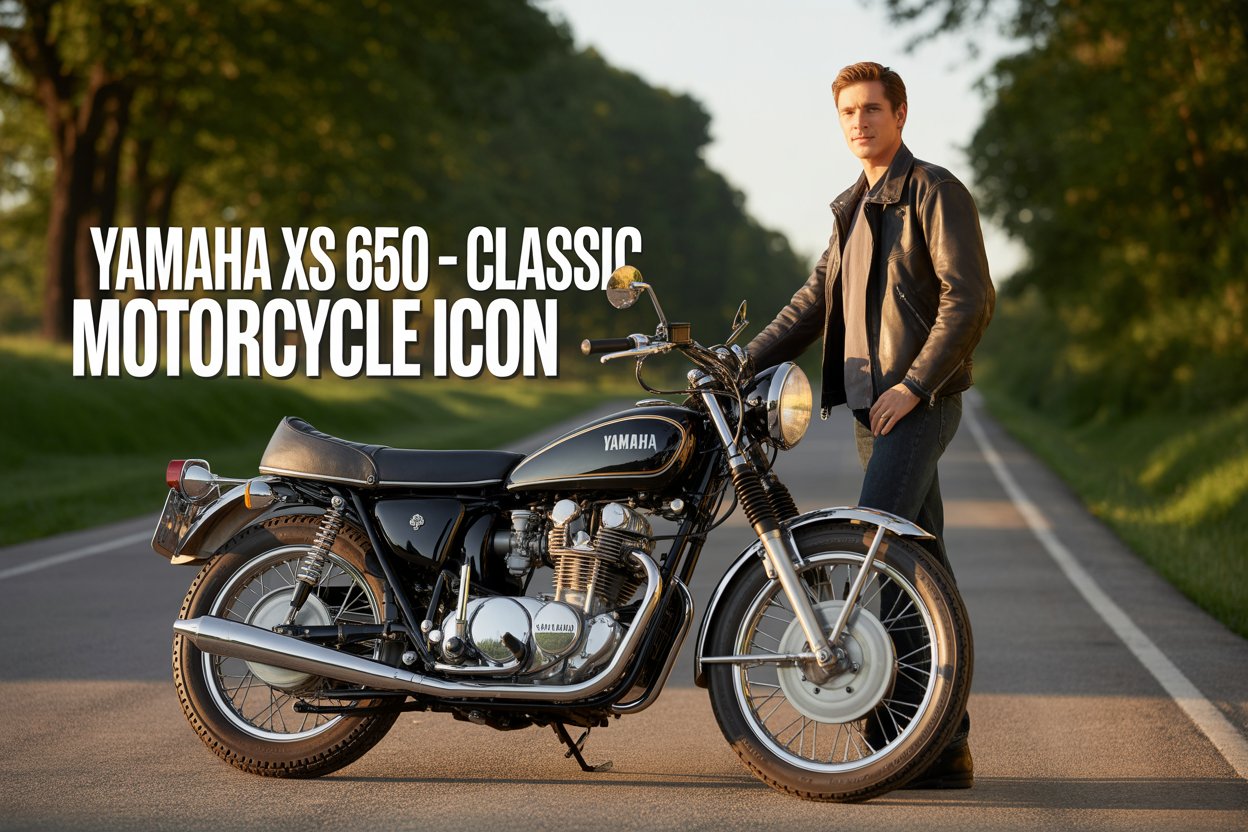
Yamaha XS 650: A Classic Motorcycle Icon
The Yamaha XS 650 stands as one of the most iconic motorcycles ever produced, blending timeless design with impressive engineering. For motorcycle enthusiasts, understanding its history, performance, and design features is essential when exploring classic bikes. Within the first glance, the Yamaha XS 650 delivers both a smooth riding experience and robust reliability, much like modern innovations in electric two-wheelers such as the KTM electric bicycle or Rivian electric bike, bridging the gap between performance and sustainability.
Originally launched in the early 1970s, the Yamaha XS650 Bike quickly gained recognition for its innovative twin-cylinder engine and durable frame. Variants such as the 1978 XS650 Special and earlier models like the 1971 Yamaha XS650 showcased Yamaha’s commitment to quality, design, and rider satisfaction. Today, the Yamaha XS 650 continues to captivate enthusiasts with its blend of vintage charm and engineering excellence.
History of Yamaha XS 650
The Yamaha XS 650 made its debut in 1969 as Yamaha’s first large-capacity motorcycle designed for both performance and reliability. It was created to compete with European bikes, especially British twins, which dominated the market at that time.
Key historical milestones include:
- 1970 XS-1: The first production model, featuring a 654cc parallel-twin engine.
- 1971 Yamaha XS650: Introduced refined components and improved handling, gaining popularity in North America.
- 1978 XS650 Special: A customized, more stylish variant designed for riders who preferred a cruiser look with a teardrop fuel tank and chopper-style handlebars.
- 1985: The final production year of the classic XS 650 before Yamaha shifted focus to newer models.
The bike’s durable frame, powerful engine, and classic design helped it gain a loyal following among riders seeking both performance and reliability. Similar to how the Tata Classic 110 bike appeals to modern riders, the Yamaha XS 650 became a benchmark for comfort and engineering.
Engine and Performance
The Yamaha XS 650 is renowned for its parallel-twin, four-stroke engine, which delivers smooth power and reliability. Its engineering allowed for both city commuting and long highway rides with ease. Riders today can compare the XS 650’s classic engine with modern offerings like the Tata Classic 110 bike in terms of efficiency and durability.
Engine Specifications:
| Feature | Specification |
|---|---|
| Engine Type | 654cc parallel-twin, air-cooled |
| Power Output | 53 hp @ 7,500 rpm |
| Torque | 53 Nm @ 6,500 rpm |
| Transmission | 5-speed manual |
| Carburetor | Mikuni 34mm |
| Ignition | Mechanical points / later CDI |
| Top Speed | 170 km/h |
Performance Highlights:
- Smooth and responsive engine, ideal for cruising.
- Balanced handling thanks to a rigid frame and well-tuned suspension.
- Fuel efficiency of around 25-28 km/l, impressive for a classic twin-cylinder bike.
The Yamaha XS650 Bike remains a reliable performer even after decades, demonstrating Yamaha’s engineering prowess. When comparing with modern EV bikes like the Chevy Equinox EV, it’s clear that the XS 650 was ahead of its time in terms of rider-friendly performance.
Design and Features
The design of the Yamaha XS 650 blends classic motorcycle aesthetics with functional engineering. Riders often admire its vintage appeal and simple, durable layout, which contrasts interestingly with futuristic designs like the Hummer EV and Tata Nano EV 2025, where technology heavily influences styling and ergonomics.
Notable Features:
- Classic Twin Headlamp Setup: Provides both style and effective illumination.
- Teardrop Fuel Tank: Iconic design seen in variants like the 1978 XS650 Special.
- Comfortable Seating: Designed for long-distance riding with a well-padded seat.
- Instrumentation: Basic yet functional, featuring speedometer, tachometer, and indicator lights.
- Chrome Detailing: Enhances the vintage aesthetic and collector appeal.
The Yamaha XS 650 is also widely customizable, with aftermarket parts and accessories available for riders who wish to restore or modify their bikes.
Popular Variants
The Yamaha XS 650 saw several variations throughout its production, each catering to different riding preferences.
1. 1978 XS650 Special
- Introduced a chopper-style design with longer forks and unique handlebars.
- Equipped with a slightly lower seat for improved comfort.
- Targeted at riders who wanted a cruiser aesthetic without sacrificing performance.
2. 1971 Yamaha XS650
- Early production model featuring classic parallel-twin engineering.
- Favored for its raw performance and simplicity, making it easier to maintain.
3. Yamaha XS650 Bike Standard Models
- Balanced between performance and practicality.
- Ideal for daily riders and enthusiasts restoring classic motorcycles.
These variants contributed to the Yamaha XS 650’s enduring popularity, making it a collector favorite worldwide. Much like modern EV bikes such as the Rivian electric bike, each variant has its own niche appeal.
Restoration and Maintenance Tips
Restoring a Yamaha XS 650 requires attention to detail, but the bike’s simple design makes it manageable for most enthusiasts.
Tips for Maintenance:
-
Engine Care: Regular oil changes and inspection of carburetors.
-
Electrical System: Check and replace points, wiring, and later CDI systems.
-
Suspension and Brakes: Ensure proper lubrication and periodic replacement of worn components.
-
Rust Prevention: Keep chrome parts polished and frame painted.
-
Fuel System: Clean carburetors and replace fuel lines as needed.
Restoration not only enhances aesthetics but also ensures reliable performance, preserving the bike’s value. Owners of the 1978 XS650 Special often find aftermarket parts easy to source, similar to components for EV bikes like the Tata Nano EV 2025.
Yamaha XS 650 Market Value and Collector Appeal
The Yamaha XS 650 has seen a steady increase in market value over the years due to its classic design and reliability. Vintage models like the 1978 XS650 Special and 1971 Yamaha XS650 often fetch higher prices, especially when well-maintained.
Estimated Market Value (in INR):
| Model | Condition | Approx. Price |
|---|---|---|
| 1971 Yamaha XS650 | Restored | 3,50,000 – 5,00,000 |
| 1978 XS650 Special | Original/Restored | 4,00,000 – 6,00,000 |
| Standard XS 650 | Good Condition | 2,50,000 – 4,00,000 |
Collector interest remains high because the Yamaha XS 650 represents an era of simple engineering, reliability, and timeless design, much like the appeal of KTM electric bicycles in modern electric two-wheelers.
Pros and Cons
Pros:
- Classic design with timeless appeal
- Reliable and durable engine
- Strong aftermarket support for restoration
- Comfortable for long rides
- Collector value appreciation
Cons:
- Older models require regular maintenance
- Limited modern features (ABS, fuel injection)
- Harder to source original parts for very early models
Yamaha XS 650: Riding Experience Chart
| Attribute | Rating (1-5) |
|---|---|
| Engine Performance | 5 |
| Comfort | 4 |
| Handling | 4 |
| Fuel Efficiency | 4 |
| Collector Value | 5 |
This chart highlights the Yamaha XS 650’s strengths in performance, comfort, and collector appeal, similar to how enthusiasts evaluate modern EV bikes like the Chevy Equinox EV and Hummer EV.
Conclusion
The Yamaha XS 650 remains an enduring symbol of motorcycle engineering, blending classic aesthetics, reliable performance, and collectibility. Whether it’s the cruiser-styled 1978 XS650 Special, the vintage 1971 Yamaha XS650, or the standard XS 650 models, every variant showcases Yamaha’s commitment to quality and rider satisfaction.
For enthusiasts, the Yamaha XS650 Bike is more than a motorcycle; it’s a piece of history that continues to inspire riders and collectors worldwide. With proper maintenance, restoration, and care, this iconic bike will remain a cherished classic for generations, just as modern electric bikes continue to redefine urban commuting.
Q1. What is the top speed of the Yamaha XS 650?
A: The Yamaha XS 650 can reach a top speed of approximately 170 km/h, depending on the model and condition.
Q2. How many variants of the Yamaha XS 650 exist?
A: There are several, including the standard XS 650, the 1978 XS650 Special, and early models like the 1971 Yamaha XS650.
Q3. Is the Yamaha XS650 Bike suitable for beginners?
A: Yes, the bike has manageable power delivery and stable handling, making it beginner-friendly with proper training.
Q4. Can I use modern fuel in the Yamaha XS 650?
A: Yes, but it is recommended to use unleaded petrol and maintain the carburetor regularly to prevent damage.
Q5. How much does a restored 1978 XS650 Special cost today?
A: Prices range from INR 4,00,000 to 6,00,000, depending on condition and originality.
Q6. Are spare parts available for the Yamaha XS650 Bike?
A: Yes, aftermarket parts are widely available, and some original components can be sourced from specialty dealers.
Q7. What makes the Yamaha XS 650 a collector’s favorite?
A: Its classic twin-cylinder engine, vintage design, and reliable performance make it highly desirable among collectors.
Q8. How often should I service the Yamaha XS 650?
A: Regular servicing every 3,000–5,000 km is recommended for optimum performance and longevity.
Add a comment Cancel reply
Comments (0)
VinFast Car Price in India 2025: VF6, VF7 Launch & EV Guide
[…] and younger riders seeking a stylish yet functional ride. Comparisons with bikes like the 1971 Yamaha XS 650 show how manufacturers are reviving vintage elements for modern […]
Yamaha XS 650: History, Variants, Specs & Collector Guide
[…] Interestingly, this modern craftsmanship echoes the timeless appeal of retro motorcycles like the 1971 Yamaha XS 650, combining performance and visual […]
Categories
- Article (32)
- Bike Reviews (1)
- Car News (12)
- Car Reviews (5)
Recent Posts
About us










